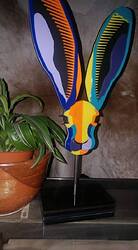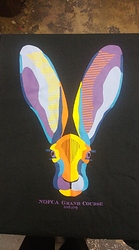I’ve been reading a lot about cutting non proofgrade acrylic. I haven’t seen anyone talking about masking the acrylic prior to use. Does anyone have experience with this? I ordered some mirrored acrylic from Canal Plastics and I’m wondering if I need to add my own masking over the top. If so, I’d love to hear what everyone has used to do this.
Also, I’m assuming that using the “proofgrade” option from the drop down is the best way to go as far as choosing settings. Feel free to leave any tips for this newbie below.
XOXO
Mirrored or reflective anything you need to mask else risk damaging the GF laser. Even then, there might be concern pending the thickness of the layer removed vs. depth of the mirror/reflective bits. (I’m sure there are other posts about it, or others with more experience with mirrored/reflective will reply).
I’ve used a fair amount of cast acrylics I’ve bought from other sources–usually it’s already masked, if not, I add my own. I start with the PG settings, and adjust for thickness, and I rarely have an issue etching, but I’ve learned try to wriggle the piece before I remove anything from the bed, to verify if it’s been cut cleanly, or if I need to run a second pass for the cutting only… much easier and less waste than pulling out of the bed and then realizing it’s not fully cut. (Been there, done that!).
Do a quick search of the forum for mirrored acrylic. There are several posts and pictures of projects as well as tips regarding masking. I cut with masking on and engrave with it removed.
So what do you use to mask?
I’ve never bought new acrylic that was not masked. Cast acrylic is masked with a paper masking. Extruded plastic is often masked with a thin plastic covering. I don’t use extruded - it’s not satisfactory for the engraves and things I do with acrylic. If I were to use acrylic I’d peel off the plastic covering and replace it with other masking - anything from painters tape to vinyl transfer tape (it’s not vinyl). If you decide to use extruded acrylic do a search here an masking and you’ll find lots of sources.
This isn’t completely true. The mirroring must be infrared reflective to damage the laser. Copper for example is a very good IR mirror and you must use extreme care when working with copper and copper alloys. From what I have read, most mirrored acrylic is not IR reflective and to the GF laser the mirror coating doesn’t exist. IIRC, this is from Dan at GF.
If you have the correct settings, you don’t need to mask acrylic…BUT…if you don’t have the correct settings, you can get flashback that will melt ripples into the edges. So I do like to use paper masking on acrylics.
I use something similar to this:
You need to brayer or scrape it after application to activate the adhesive, but it’s pretty easy to apply and remove.
Thank you everyone for your help. Can’t wait to give this a go.
ALWAYS WATCH ACRYLIC JOBS
Of all the “my GF burned up” posts we’ve had, almost all have been with acrylic. Stuff can flare up in a heartbeat, it seems. Proograde or otherwise.
Good tip.
Most of the burned GF stories from what I have seen are masking on acrylic. There were one or two where the acrylic that got too thin, but yes, I completely agree. Do not leave the GF unattended while running! Even just engraving I am in the same room paying at least half attention. During cuts I am always watching the machine.
I know you got the answers here, but I’ll chime in too. ![]() I do probably more acrylic than anything and I find that the PF acrylic setting work at least 95% of the time. Acrylic is pretty much acrylic regardless of the manufacturer, so for the most part you just have to adjust for the varying thicknesses. Even the same sheet can vary as much as 10% in thickness so it’s always good to measure it.
I do probably more acrylic than anything and I find that the PF acrylic setting work at least 95% of the time. Acrylic is pretty much acrylic regardless of the manufacturer, so for the most part you just have to adjust for the varying thicknesses. Even the same sheet can vary as much as 10% in thickness so it’s always good to measure it.
Acrylic doesn’t stain, but it can get flashback marks on the back from the tray. If I’m cutting lots of small pieces or a lot of engraving I remove the masking altogether so I don’t have to deal with it on a hundred tiny pieces. (I have my setting pretty dialed in and don’t get flashback marks really.) I do add masking when I want to paint it afterward and I leave it on the back of mirrored acrylic as the mirror coating scorches and will mess it up. As @bbum mentioned, I think arylic has been responsible for the most fires we’ve seen reported. They acrylic edge melts vs getting burned away like wood and it can really retain heat. I’m pretty comfortable in knowing what type of cutting heats up the most, but you always have to watch it. A bunch of narrow cuts all together can get really hot pretty fast.
I do this too and it’s GREAT advice! Always check that it’s cut through before moving the material.
If you get extruded acrylic, remove the plastic masking as it will melt and can sometimes make tiny little balls of plastic goo, especially when engraving. I use the paper masking @Jules linked and it works great.
Oh yeah, search for “defocusing” when engraving acrylic and give it a try. It makes for a much nicer, smooth engraving.
I finished this just last night! It was fun, but I’m glad it’s over lol. I do adore acrylic though ![]()
Your last night’s project is amazing! I love the colors. Is that all layers of different colors of acrylic or is it painted? Gorgeous. (I adore acrylic, too)
Thanks Xabbes  It’s all just regular acrylic, no painting. I designed the graphic for a T-shirt and thought it would translate into acrylic really well. I’ve sold the first acrylic version of the bust and have two folks wanting this one so I’ll be making a few more. Not a bad problem to have I guess.
It’s all just regular acrylic, no painting. I designed the graphic for a T-shirt and thought it would translate into acrylic really well. I’ve sold the first acrylic version of the bust and have two folks wanting this one so I’ll be making a few more. Not a bad problem to have I guess.
Thanks for sharing your expertise. Your artwork is amazing translated into acrylic.
No…not a bad problem to have at all! And, one more question…are those different colors all inlaid or are they layered one on top of another? Can’t tell the depth of the piece.
They are layered. There’s a solid back piece and some of the other layers run the full length of the head to give it strength. Those ears are pretty fragile and I broke several base pieces. :-/
Thanks for correction–but always better to be safer than sorry, eh?
Up to the point that you don’t do a project that is perfectly safe because you are working with information that isn’t true.
A point of note. Alcohol Sanitizer dissolves most adhesives (including MDF  ) and while wood can be warped, Acrylic cannot, so dissolving the adhesive solves the problem of weeding no matter how intricate,
) and while wood can be warped, Acrylic cannot, so dissolving the adhesive solves the problem of weeding no matter how intricate,


